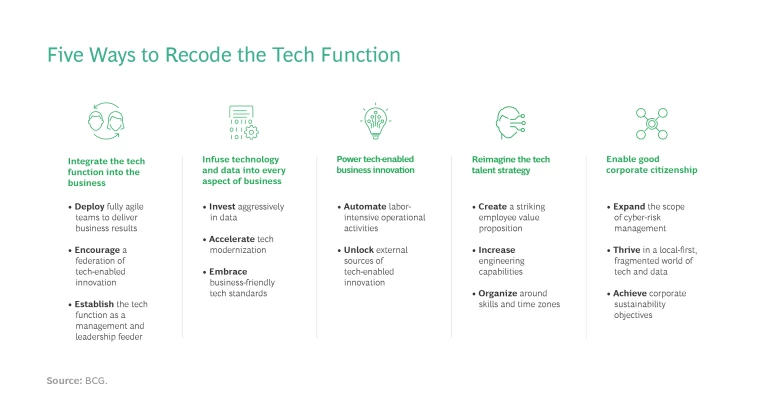Technology leaders are in a race to become world class in a world that is not standing still. The technology function of the future will look and act nothing like the tech function of today. Changes in the technology landscape, from quantum computing and the explosion of data to the democratization of coding, will force a transformation in the fundamental purpose, function, and scope of the tech function.
Although we’ve long heard that the tech function must become a strategic partner of the business and that all businesses are becoming tech businesses, four developments are making these shifts more urgent:
- Technology has been unleashed. The ubiquitous adoption of cloud computing and the rise of low-code and no-code platforms, for example, are putting powerful tools in the hands of citizen developers outside of the traditional tech-function boundaries.
- Technology is changing how people create, work, learn, and consume. The outer bounds of the possible in artificial intelligence, augmented reality, the Internet of Things (IoT), blockchain, and the metaverse are still largely unexplored.
- The shortage of specialized tech talent is forcing the tech function to work differently. Specifically, it must free up human capacity through automation and deploy that capacity in higher-value activities. With their needs for tech know-how so great, companies will also have to rely on outside expertise from partnerships, joint ventures, and other collaborations.
- The tech function is having to address increasing risks on multiple fronts. New information-related assets require expanded cyber-risk management. Also, as risks related to climate change increase, organizations are looking to tech functions to identify and help abate emissions within operations and supply chains. In addition, legal and policy risk is also rising as global companies strive to comply with local laws and regulations. Data-protection regulation, for example, is becoming more complex as the amount of data explodes.
Welcome to the dawn of a new era for the tech function.
Recoding the Tech Function
Typically, tech teams spend most of their time keeping day-to-day operations humming, even though most tech leaders know they will ultimately be judged on enabling business capabilities and creating value. A recent survey of more than 100 corporate tech leaders in Europe, for example, underscored that “deep technologies” are becoming mainstream in many industries. In these times, focusing on the basics is not enough. Tech leaders need answers to five critical questions.
- How can leaders move beyond aspirations and create fully cross-functional teams of both business and tech people who share common goals and work together productively?
- How can leaders accelerate tech modernization to fully hardwire AI, data, and technology into the business?
- How can automation and partnerships with external collaborators be deployed to free up scarce tech talent and spark innovation?
- What should leaders do to reimagine their tech talent strategy so that they can access top recruits in a labor-constrained world?
- How does the tech function help the business thrive in a world of greater regulation of AI and data, oversight, cyber risk, and expectations that organizations will institute more environmentally sustainable practices?
In the rest of this article, we’ll answer these questions by exploring five ways businesses can spur innovation and generate more value. (See the exhibit.)

Integrate the Tech Function into the Business
At a high level, many tech functions today act as strategic partners, helping employees on the business side achieve significant goals. But in the middle of the organization, the partnership between tech employees and business colleagues is often less strong. Tech leaders need to change this by embracing three initiatives.
Deploy fully agile teams to deliver business results. Ideally, agile erases the tech-business boundary by making the cross-functional team the gravitational center of the organization. But right now, too many organizations are agile in name only, because cross-functional teams are not empowered to experiment and learn. Typically, these teams face two additional problems: individual members are not adequately evaluated based on team outcomes, and teams lack continuity because they are brought together to address a specific need and then disbanded. Agile is most effective when team members are evaluated based on their contributions to team outcomes, when they remain connected over time, and when they have the authority to test and learn on their own, empowered by broad guidelines set by leadership.
Encourage a federation of tech-enabled innovation. As technology becomes easier to use and tech fluency increases, many engineering activities, such as data science and web development, will occur within the business. This trend is creating the need for the tech function to serve three distinct roles:
- As a creator and innovator of shared capabilities that business units and functions across the enterprise can readily adopt.
- As a provider of services to empower the business to innovate. The tech function builds platforms prepackaged with capabilities that the business in turn uses to design, create, and deliver new technology-enabled products and services.
- As a collaborator that facilitates innovation. The tech function establishes a marketplace for applications so that developers in one part of the business can publish their applications for other groups to reuse or adapt.
Establish the tech function as a management and leadership feeder. The digital revolution will require business leaders to become even more savvy about technology. This has already happened in e-commerce and digital marketing and will continue in other areas.
The need for technology capabilities in business puts tech functions at a crossroads. Leaders of tech functions can continue to offer employees and job candidates traditional career paths, which tend to be siloed and ceilinged. Or they can create career paths that develop well-rounded employees who can step into business roles and thrive.
By making the latter choice, tech leaders can help businesses leaders in their struggle with technology, win a seat at the table, and attract star talent to the tech function.
Broadened tech career paths will attract talent and boost businesses’ tech expertise.
As technology becomes more central to the business of Fortune 500 companies, their leadership will increasingly resemble that of the tech industry, in which CEOs often come up through engineering rather than through sales, marketing, or finance. Microsoft, Google, Adobe, and Intel, for example, are all run by engineers.
Infuse Technology and Data into Every Aspect of Business
Businesses have only just begun to understand the transformative effects of the exponential growth in data. The following strategies will help them stay on top of this growth and gain the most value from it.
Invest aggressively in data. Companies need to be prepared for a world in which they may be processing not just 10 or 100 times more data than today but potentially several orders of magnitude more, from millions of data points to trillions of data points.
Typically, each new data storage and processing solution hits its limits in a few years, forcing companies to play catchup. Those that invest in data aggressively, well in advance of the expected surge in processing demands, stand a better chance of staying ahead of the game.
Accelerate tech modernization. Many companies have multi-year plans to modernize their legacy IT, such as enterprise resource planning and business-intelligence systems. But business leaders need help now. The companies with the most mature data capabilities today have strong data sets and advanced analytics. Business leaders can gain insights and plot actions from these systems without having to pull data scattered in standalone and proprietary systems. The underlying architecture, which we call a data and digital platform, separates the data layer from legacy IT and allows organizations to scale up new digital services faster.
Embrace business-friendly tech standards. The tech function needs to be viewed more as an enabler of technological innovation than as an enforcer of standards. Business leaders often complain that governance and guardrails created by the tech function slow progress, so they work around them, creating friction and introducing technical design flaws that need to be fixed later.
This state of affairs cannot hold. One way to resolve this tension more amicably is to have the tech function deliver core tech capabilities as reusable services with built-in standards. If these reusable services are high quality and rich with features, the business will not have an incentive to reinvent the wheel.
The tech function must be seen as a partner in, not a barrier to, innovation.
Another way to resolve tensions is to set up an engineering leadership council that can step in to mediate and facilitate as opposed to govern and arbitrate. Unlike a traditional architecture review board, which consists of executives drawn solely from the tech function, an engineering leadership council is made up of a rotating number of business and tech executives. Because the council includes a business perspective, the outcomes of its efforts are more likely to be accepted. This integrated business and technology perspective will improve overall governance.
Power Tech-Enabled Business Innovation
In the new world, the ultimate test of the tech function will be whether it is helping the business innovate. That goal will be impossible to achieve unless the function can free existing capacity through automation and the creation of new capacity through external partnerships.
Automate labor-intensive operational activities. The tech function should identify ways to automate processes in both tech and business operations. This will give the tech function and the business as a whole more capacity to innovate. For example, OpenAI Codex writes code based on a particular set of requirements and desired functionality. By using such AI-for-code solutions that automate vulnerability testing and other activities, the tech function can free developers to focus on more-complex engineering challenges.
Unlock external sources of tech-enabled innovation. Most organizations tap into the expertise and capacity of a set of external systems integrators, outsourcing providers, and other partners. These longstanding arrangements work for business-as-usual activities but won’t necessarily address the demands of the future. Increasingly, the tech function will need to work with a broader set of partners, many of them offering niche services and innovations. Smaller vendors, startups, and even worker marketplaces are often a better choice in new-skill areas such as the IoT, AI, and virtual reality. This means that vendor management will be a critical new skill, encompassing how to govern a much broader group of vendors, measure their performance, and establish the right mix of generalists and specialists.
This shift to a broader ecosystem of vendors will also require a mindset shift. In a world of open innovation, the not-invented-here syndrome has to give way to a more inclusive and partner-focused approach.
Stay ahead with BCG insights on digital, technology, and data
Reimagine the Tech Talent Strategy
The recipe for a successful AI implementation is not what most people imagine. It is about 30% technology and systems and 70% people and organization. Even at the most automated, tech-savvy company, human skills will remain the most valuable assets—in particular, technology skills. The following strategies will help businesses find, attract, and keep tech talent, and expand their in-house tech capacity.
Create a striking employee value proposition. Tech leaders need to understand why their employees come to their organization and why they stay. The reasons are likely different from what they were a few years ago. For a long time, tech talent has been drawn to jobs that offer such benefits as work-life balance, strong relationships with colleagues, and attractive compensation packages. But these are just the basics. These days, employers who want to recruit the best talent must develop clear and compelling career paths, opportunities to refresh skills, interesting work and tools, and modern, flexible ways of working. These functional attributes should be married to a compelling purpose, so workers can see how their efforts make a difference.
Tech talent is demanding more—and businesses must deliver.
This package of the tangible and intangible is challenging to put into motion effectively, but businesses must strive to offer these benefits. Because tech talent remains in short supply and attrition remains high, companies lacking a strong employee value proposition will be at a disadvantage in competing for the most-skilled tech workers. Tech leaders need to listen to their talent, be honest with them about what is possible, and authentically link recruiting and messaging back to purpose.
Increase engineering capabilities. Engineering capabilities at Fortune 500 companies tell a tale of silent attrition. Many companies began outsourcing commodity IT services, such as laptop support and telecom network management, and they continued to rely on outsourcing even when the tech function’s responsibilities grew. Today, many companies have outsourced more than 70% of their technology work, including critical intellectual property. As one CIO put it, “The keys to the castle are outside the kingdom.”
Many companies are now shifting their business strategies, some so dramatically that they anticipate hiring thousands of software engineers a year. This increased need for engineering capabilities is a symptom of the shift in the role of the tech function itself. No longer is the function a “back office.” Now it is often critical to the business in developing products and services and creating irresistible customer experiences.
Organize around skills and time zones. Historically, tech leaders have looked to find talent and skills in specific geographic locations. But with the rise of remote work, companies are no longer constrained by geography. Their primary goal in hiring is to find workers with the right skills.
The most forward-thinking leaders are recruiting by time zone rather than location. They are giving people flexibility in both where and when they work, within guidelines. The human-resources function must adapt its processes and policies to meet these new challenges. At many companies, the tech function is the test case for workforce innovations that will eventually be rolled out to the entire company.
Enable Good Corporate Citizenship
The tech function will start to play a much larger role in the outside world, as the outside world makes demands on organizations and their technology and environmental footprints. Achieving the following goals will help organizations meet these demands.
Expand the scope of cyber-risk management. The tech stack of future companies will expand far beyond today’s cloud-based applications and API architecture. Companies will soon be communicating with external parties through virtual reality, using distributed ledgers for recording financial transactions, and managing self-learning algorithms. As quantum computing becomes viable, today’s encryption standards will need to be replaced with another form of protection.
As the risk environment becomes larger and more complex, companies will need to identify and manage exponentially more points of failure, vulnerabilities, and automated activities that have little or no human oversight.
Thrive in a local-first, fragmented world of tech and data. Companies that create technology products and services for a global market must comply with local laws and regulations. These include regulations on consumer data privacy, such as the General Data Protection Regulation (GDPR) in the European Union; South Korea’s Personal Information Protection Act, one of the strictest privacy laws in the world; and Brazil’s General Data Protection Law, which is similar to the GDPR in protection levels. Companies expanding into or collecting data in any region must be prepared to track consent and store data according to local procedures.
All of this means that the tech function must balance global product consistency, interoperability, and economies of scale with specific local regulations. Consequently, it will need to build products based on reusable platforms and microservices that allow for consistent execution and customization for local regulations. It will also need to stay abreast of such regulations and incorporate them into the design of products. Finally, it will need to maintain playbooks to address constantly changing local regulatory requirements.
Achieve corporate sustainability objectives. Tech functions must play three primary roles to help their organizations address the climate crisis:
- Enable the business to meet green-certification and compliance rules through modeling and reporting capabilities.
- Responsibly manage the carbon footprints of tech operations and supply chains by, among other things, reducing computational-energy consumption.
- Enable the business to reduce its overall carbon footprint by detecting energy leakages and improving virtual collaboration to cut travel.
This ambitious agenda will require culture change, investment, and a break from the past. But tech leaders who fulfill it will have an opportunity to attain a level of influence and credibility that was unthinkable not that many years ago. They will also help the tech team emerge from the shadows and be seen as an engine of value creation rather than a cost center. It’s time to seize these opportunities and start reaping the rewards.









